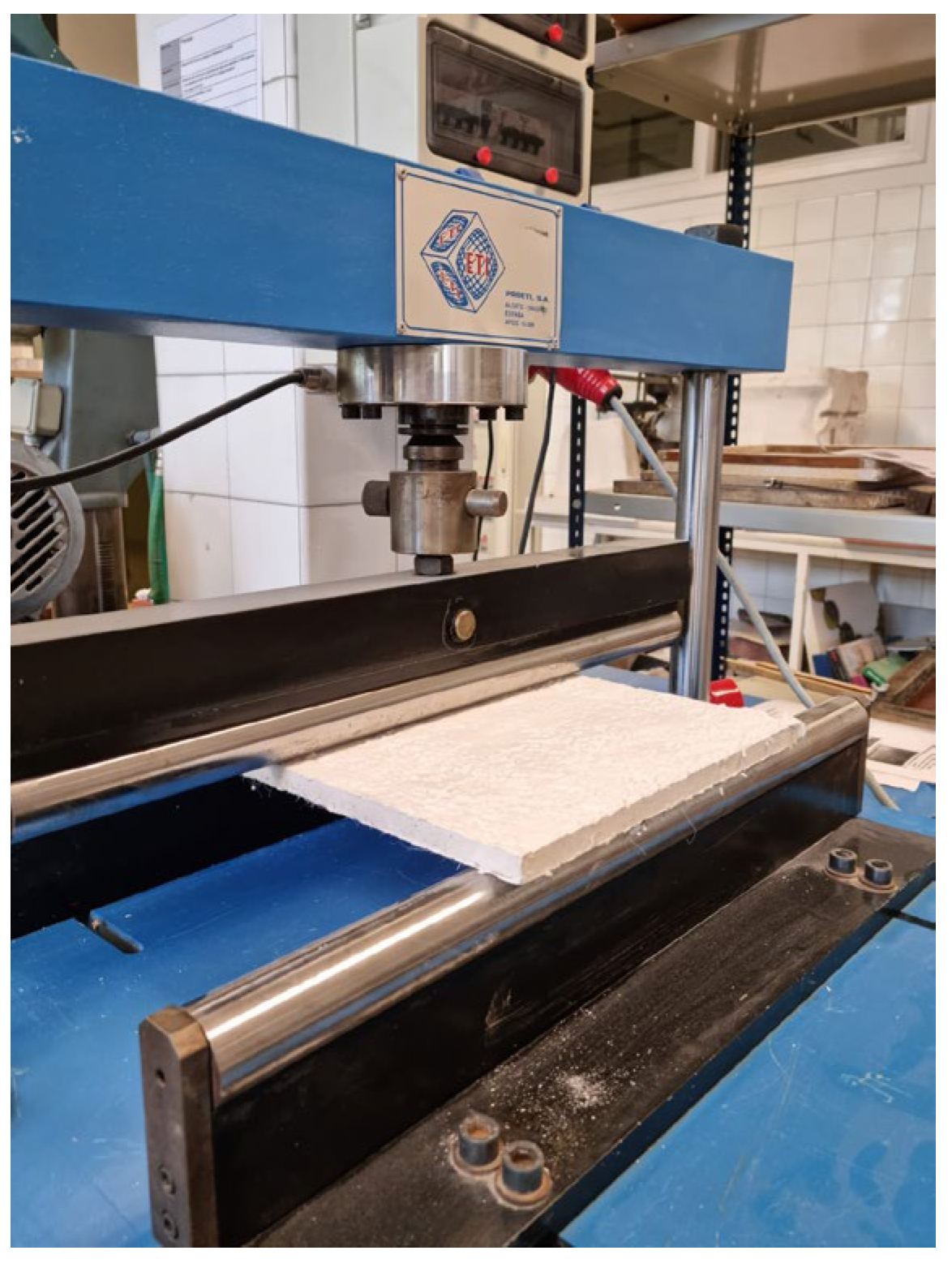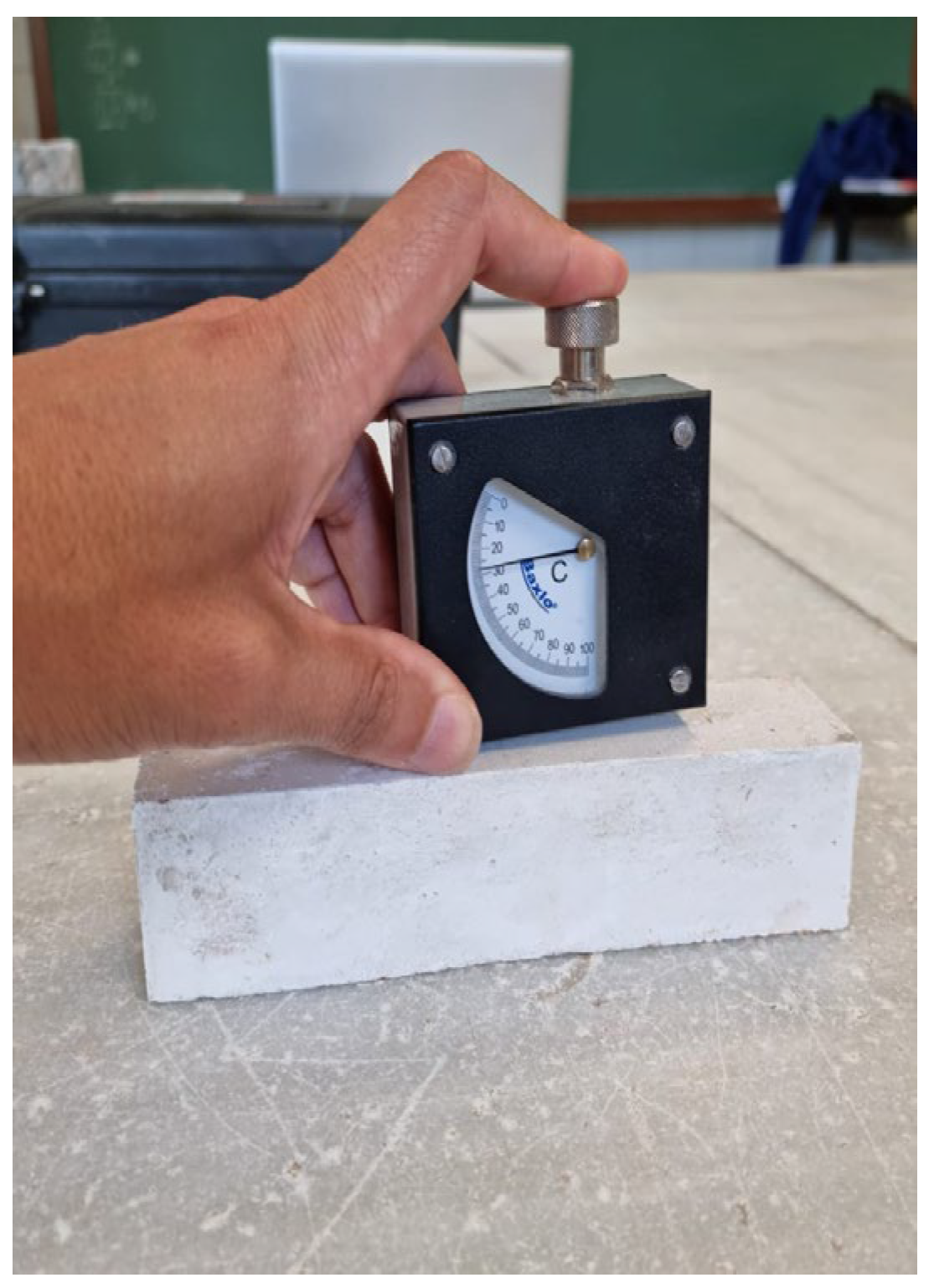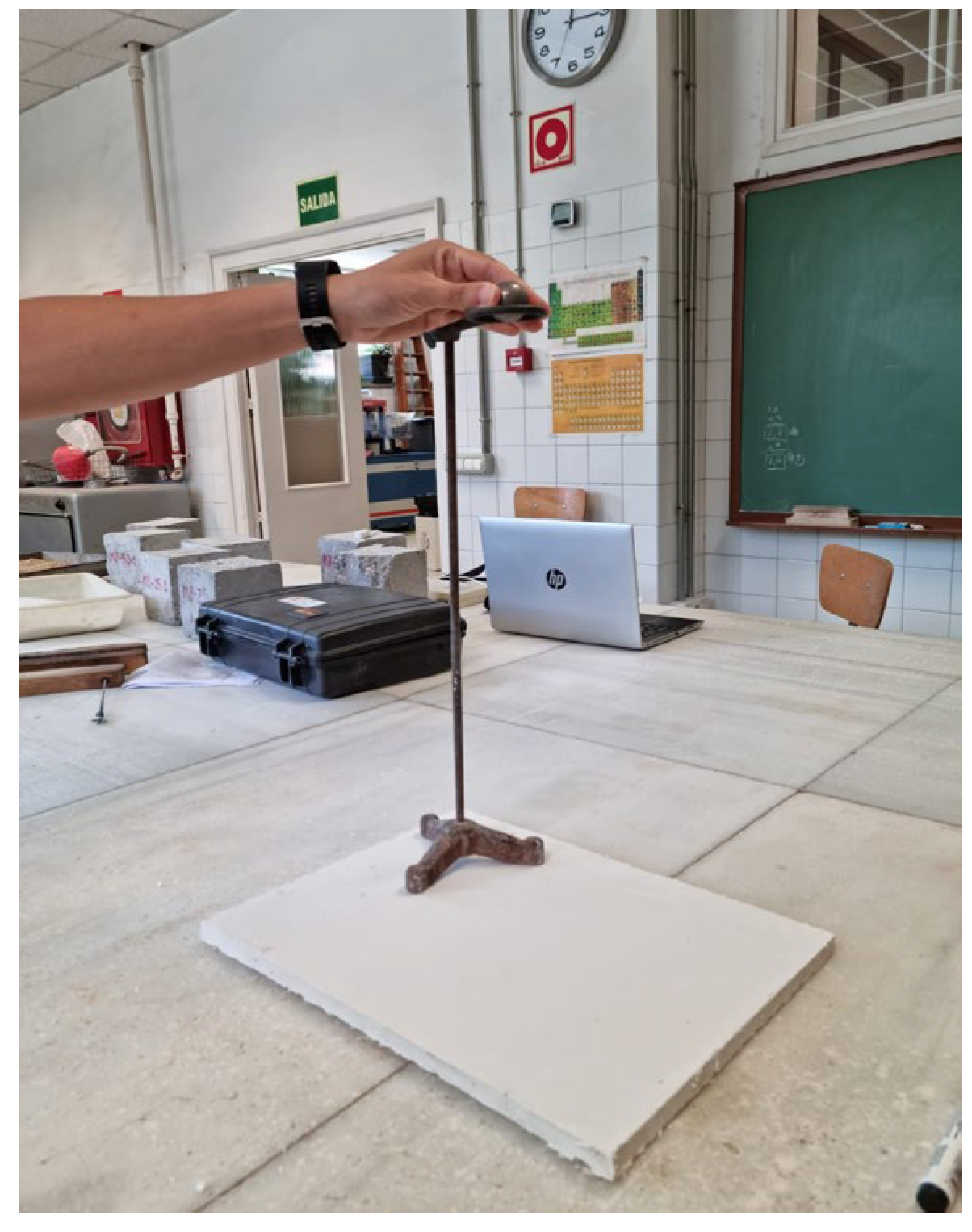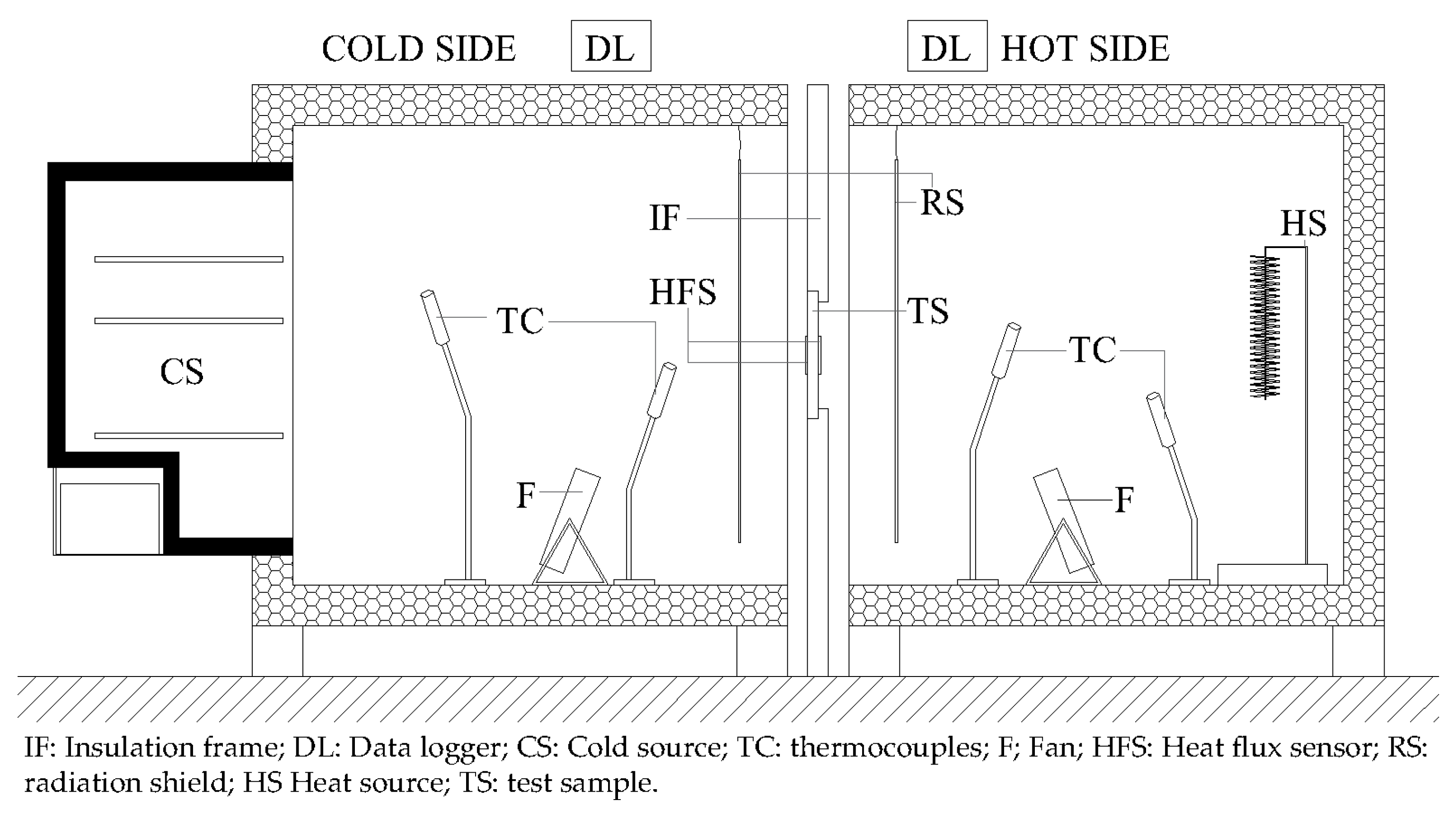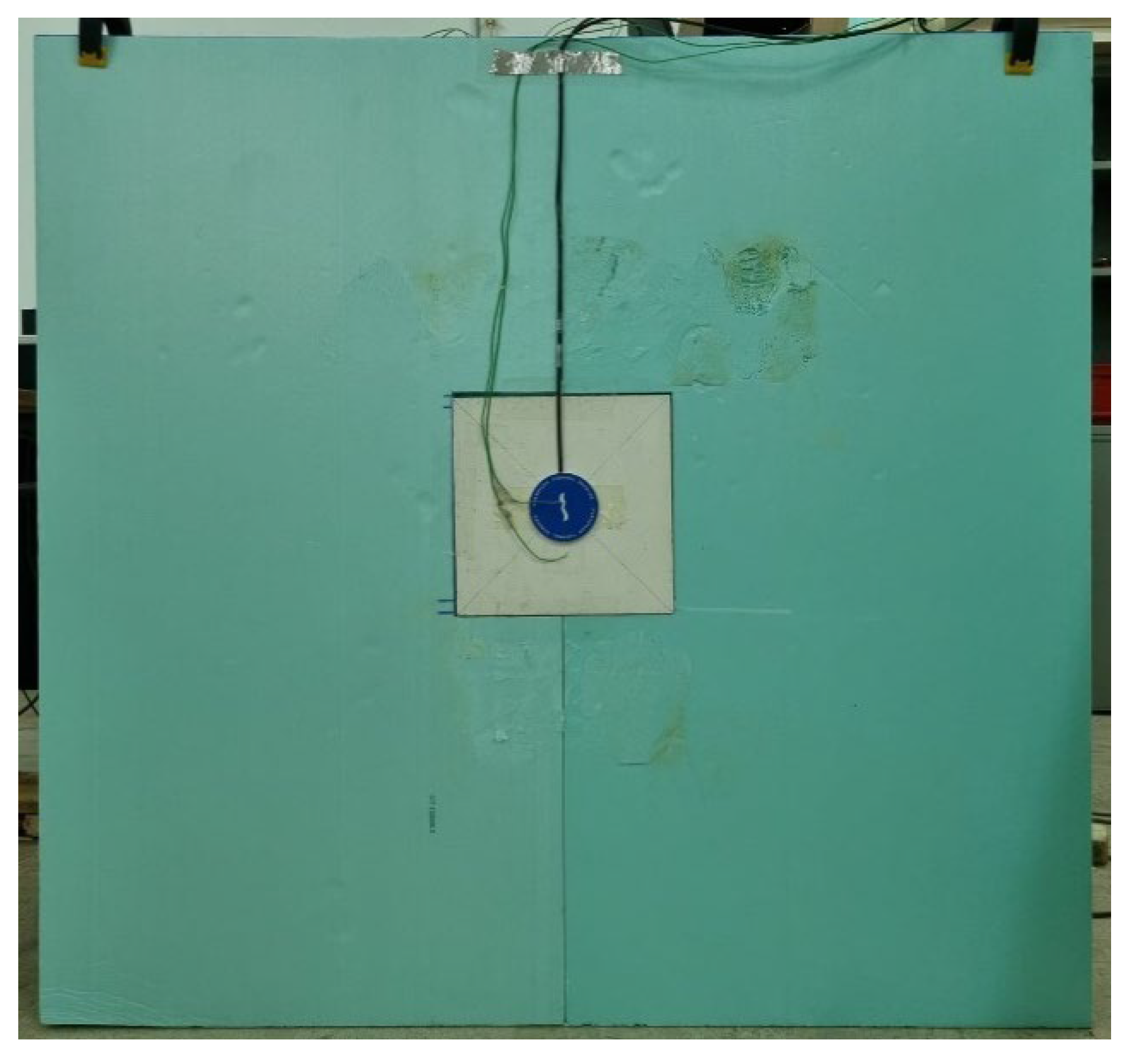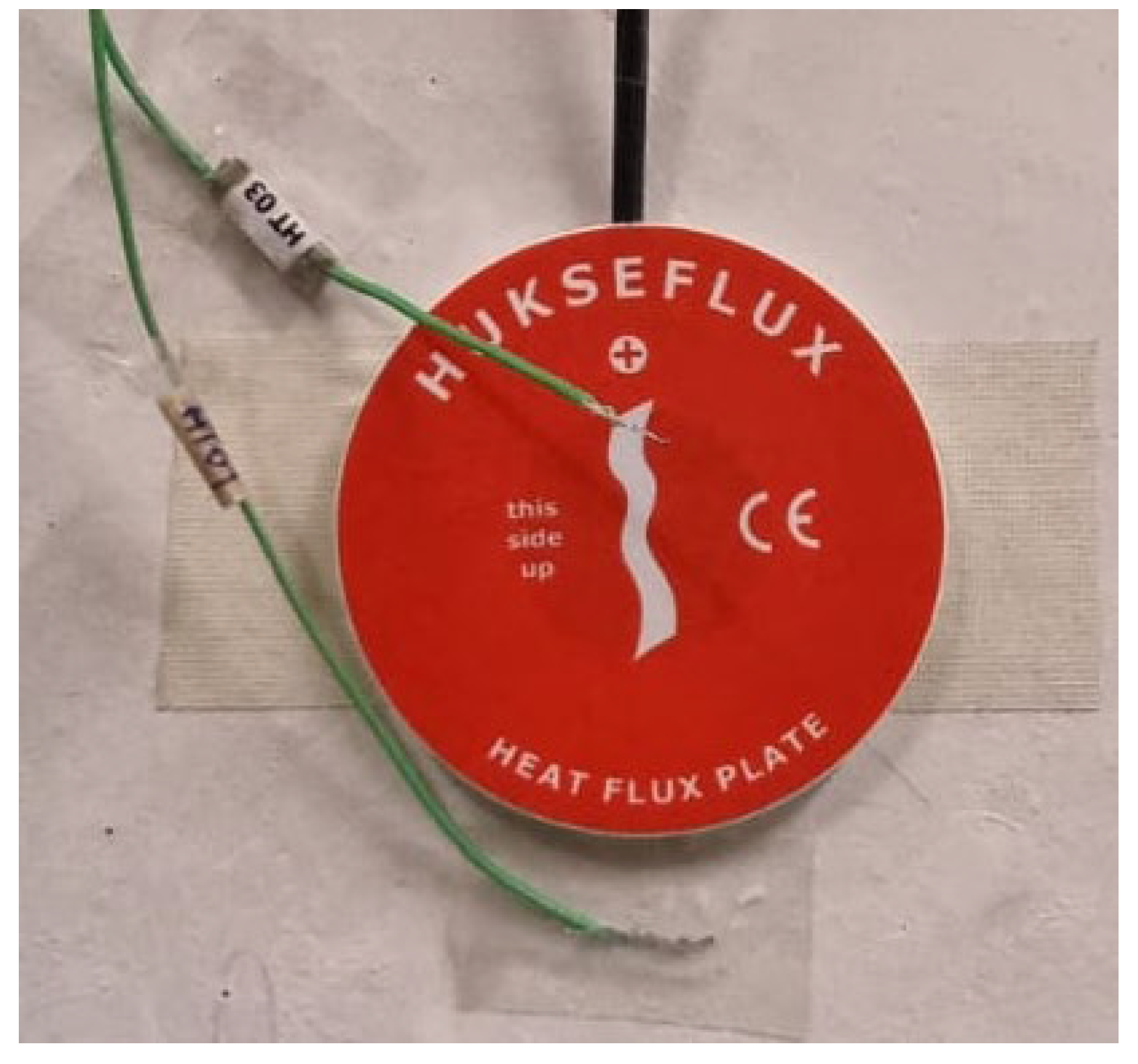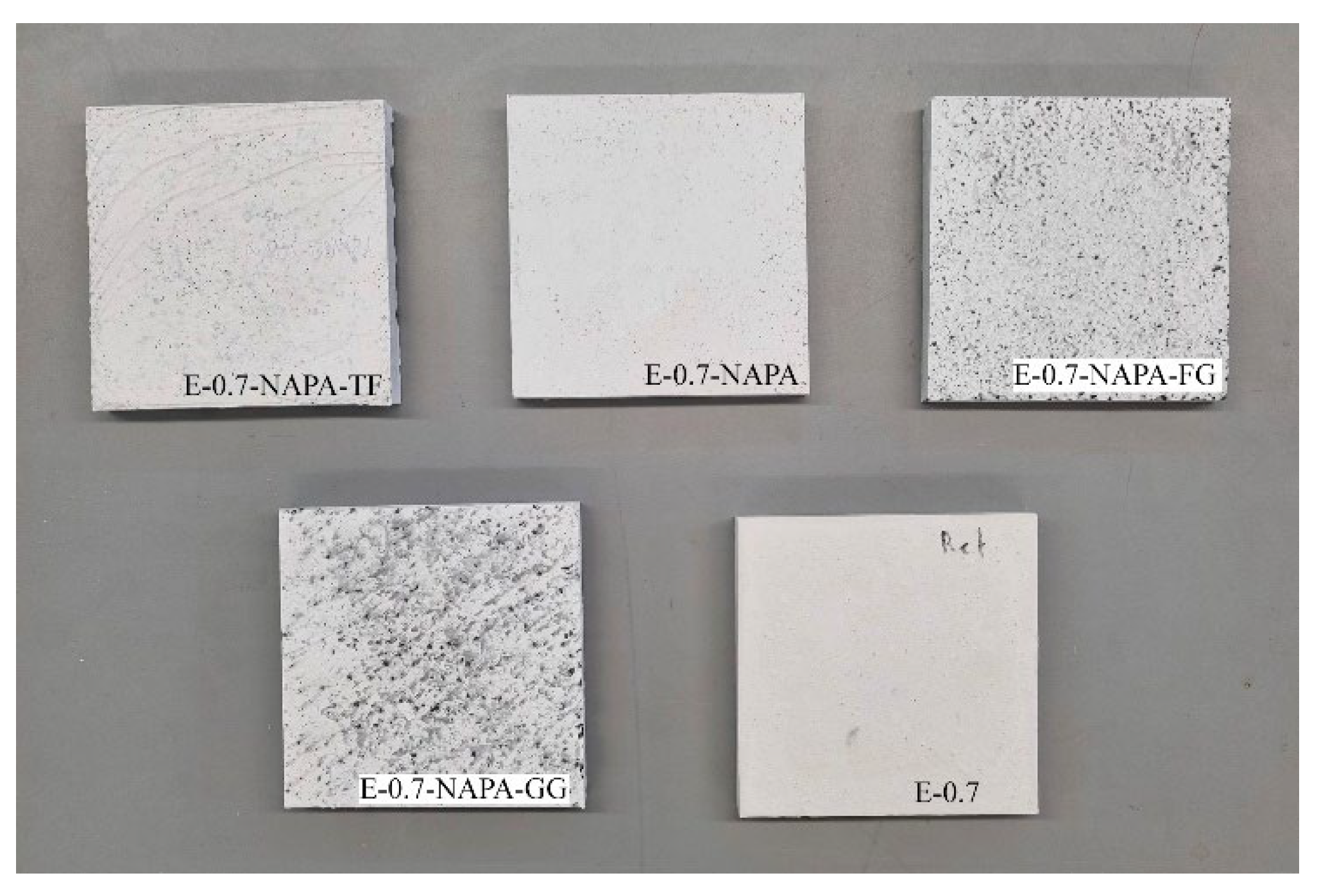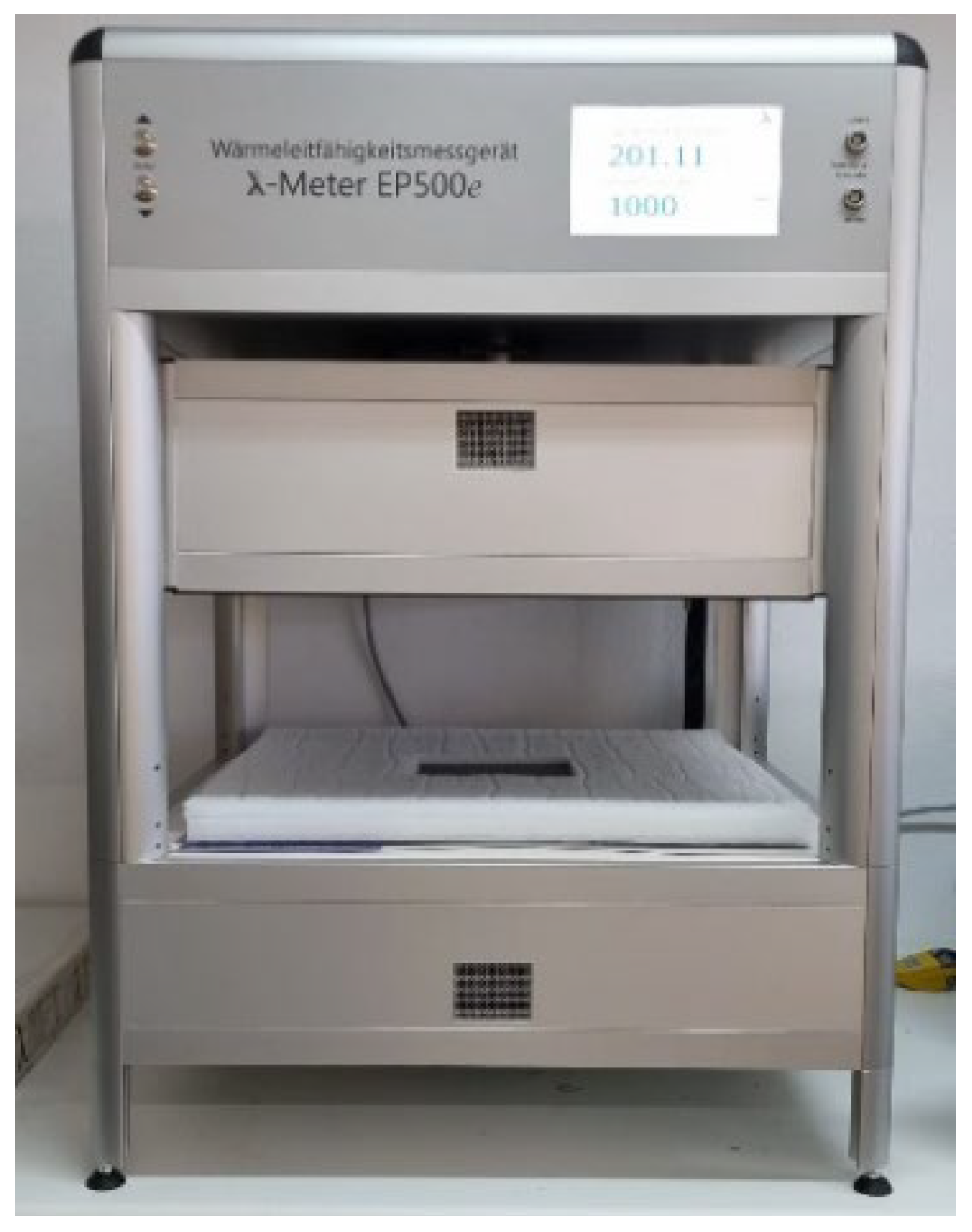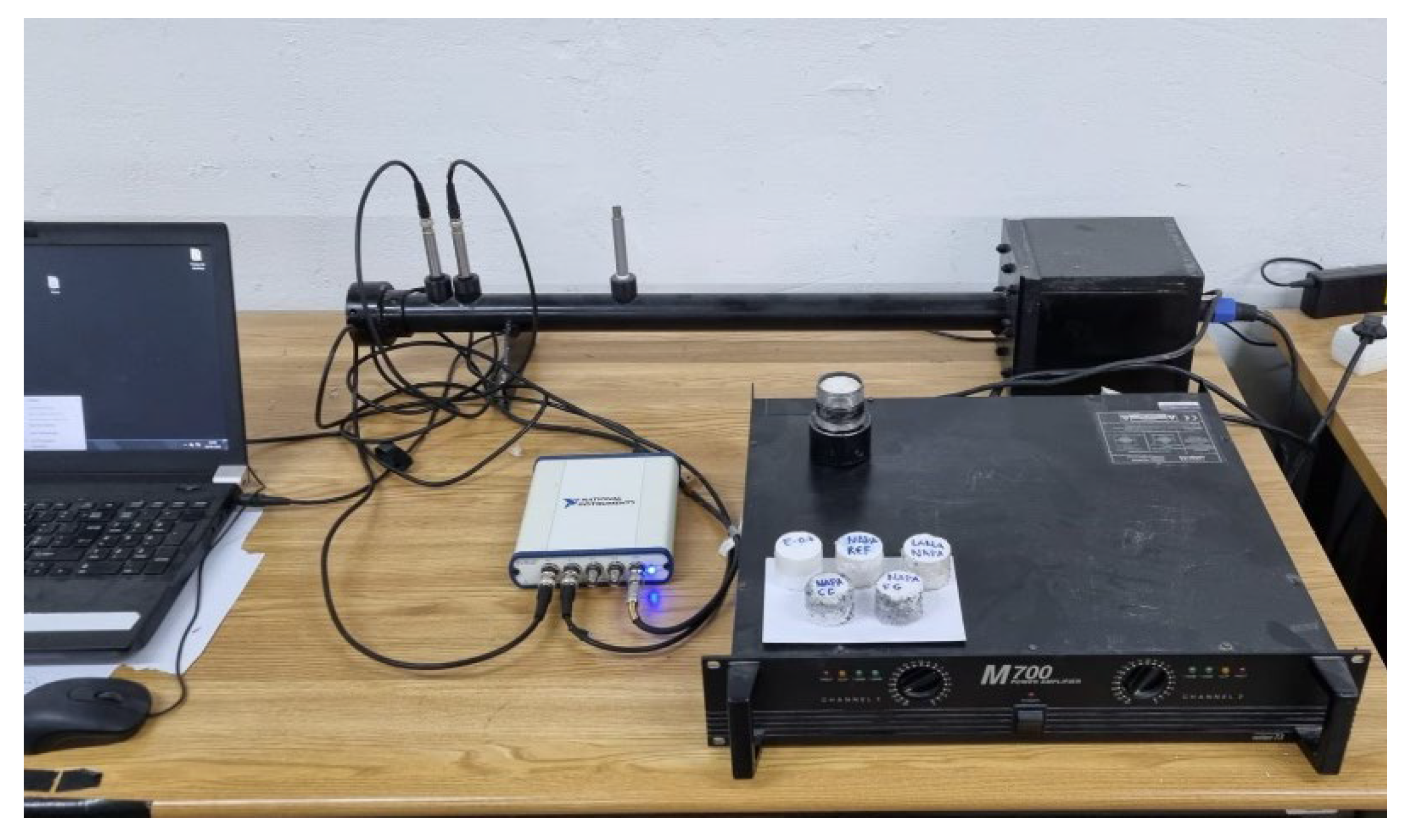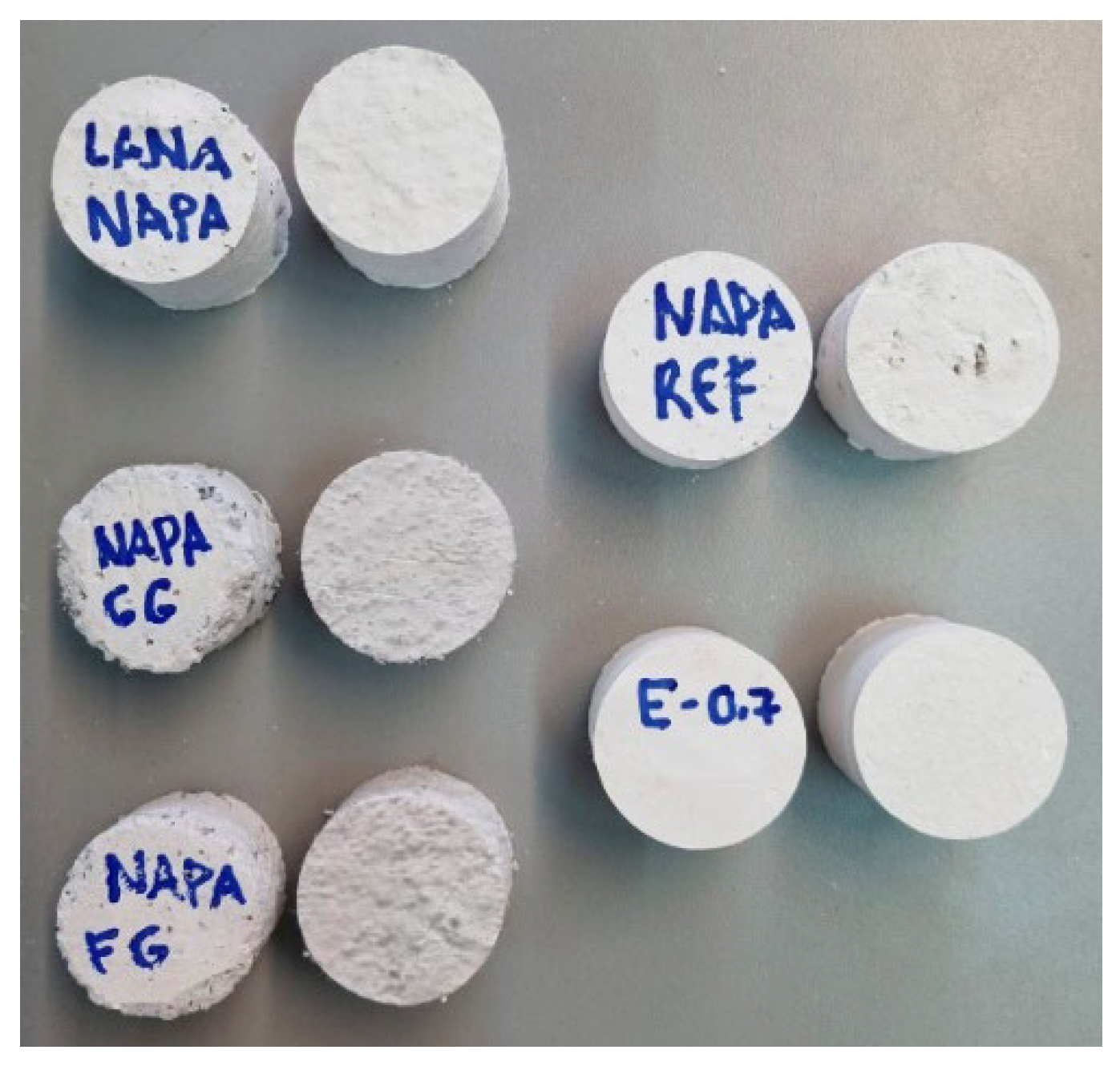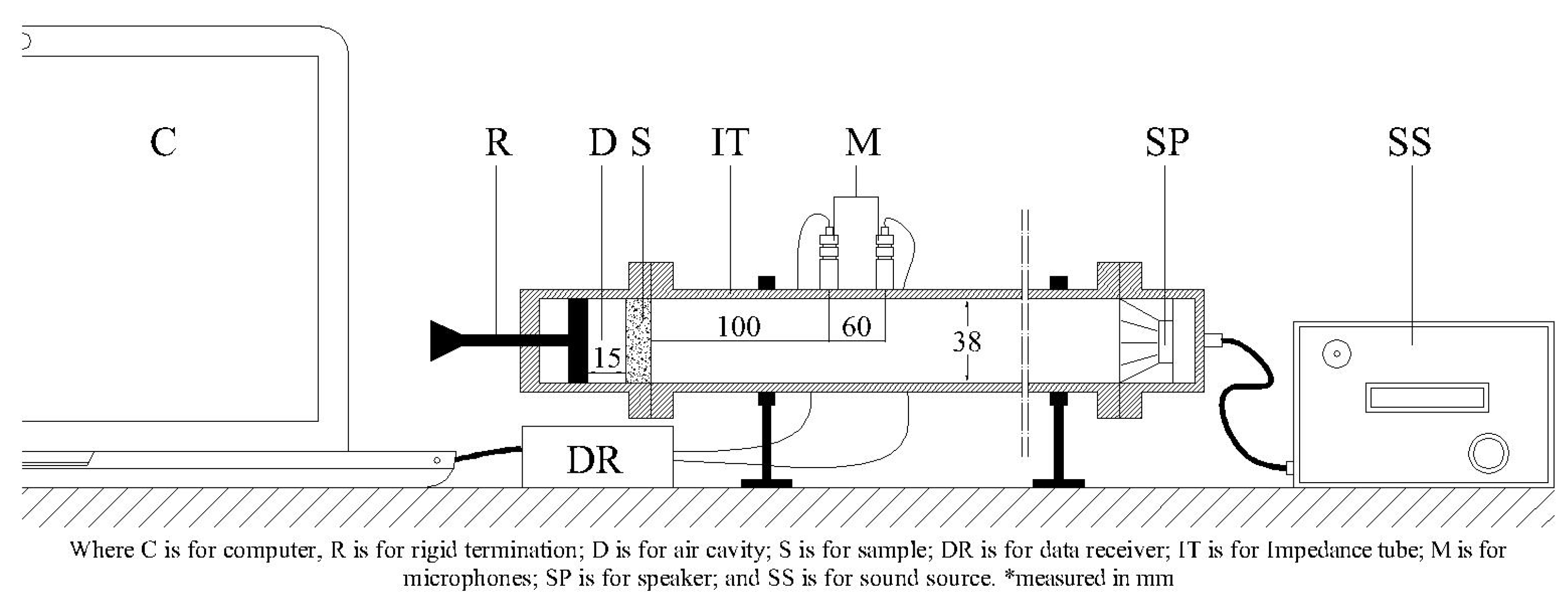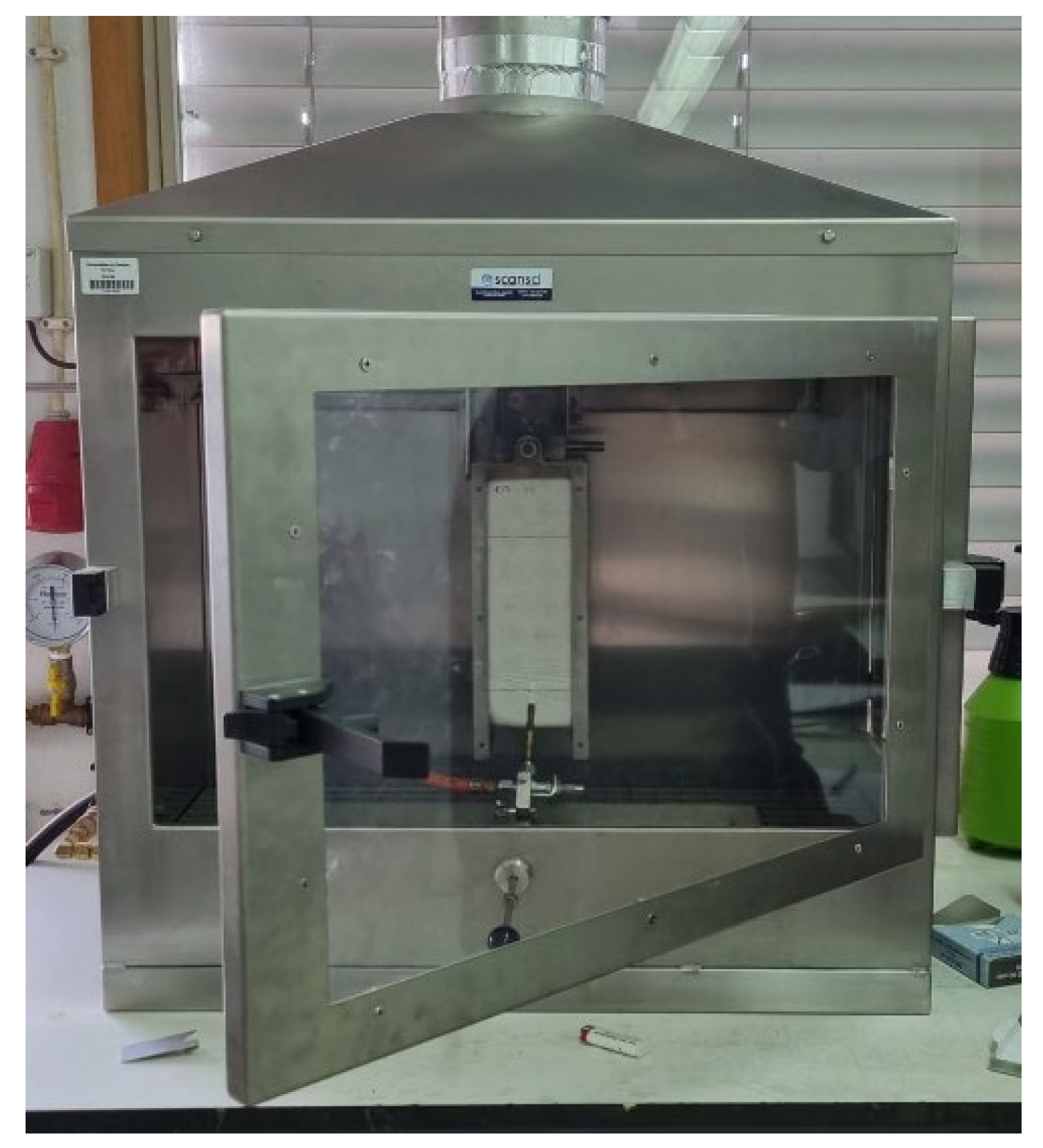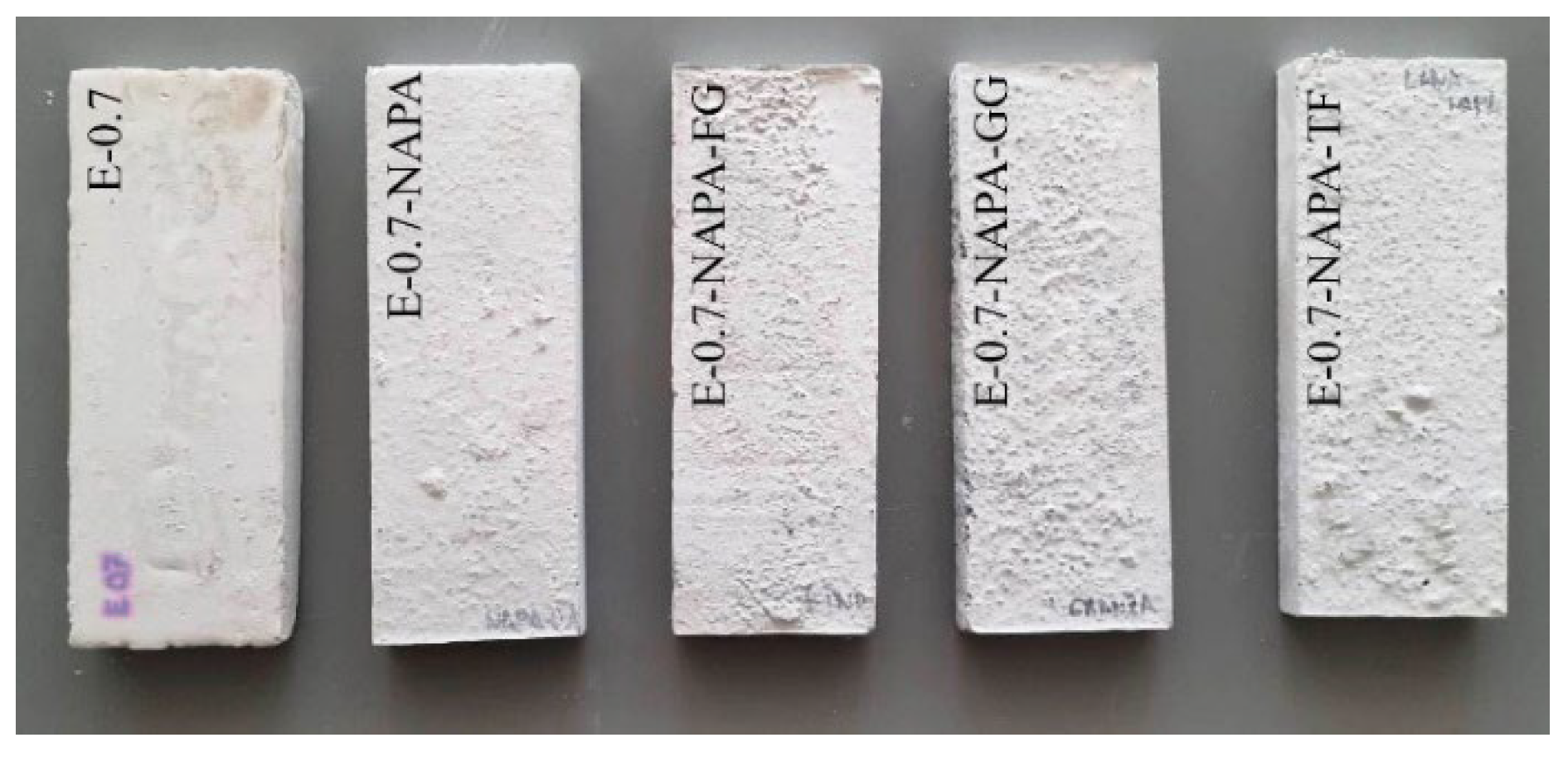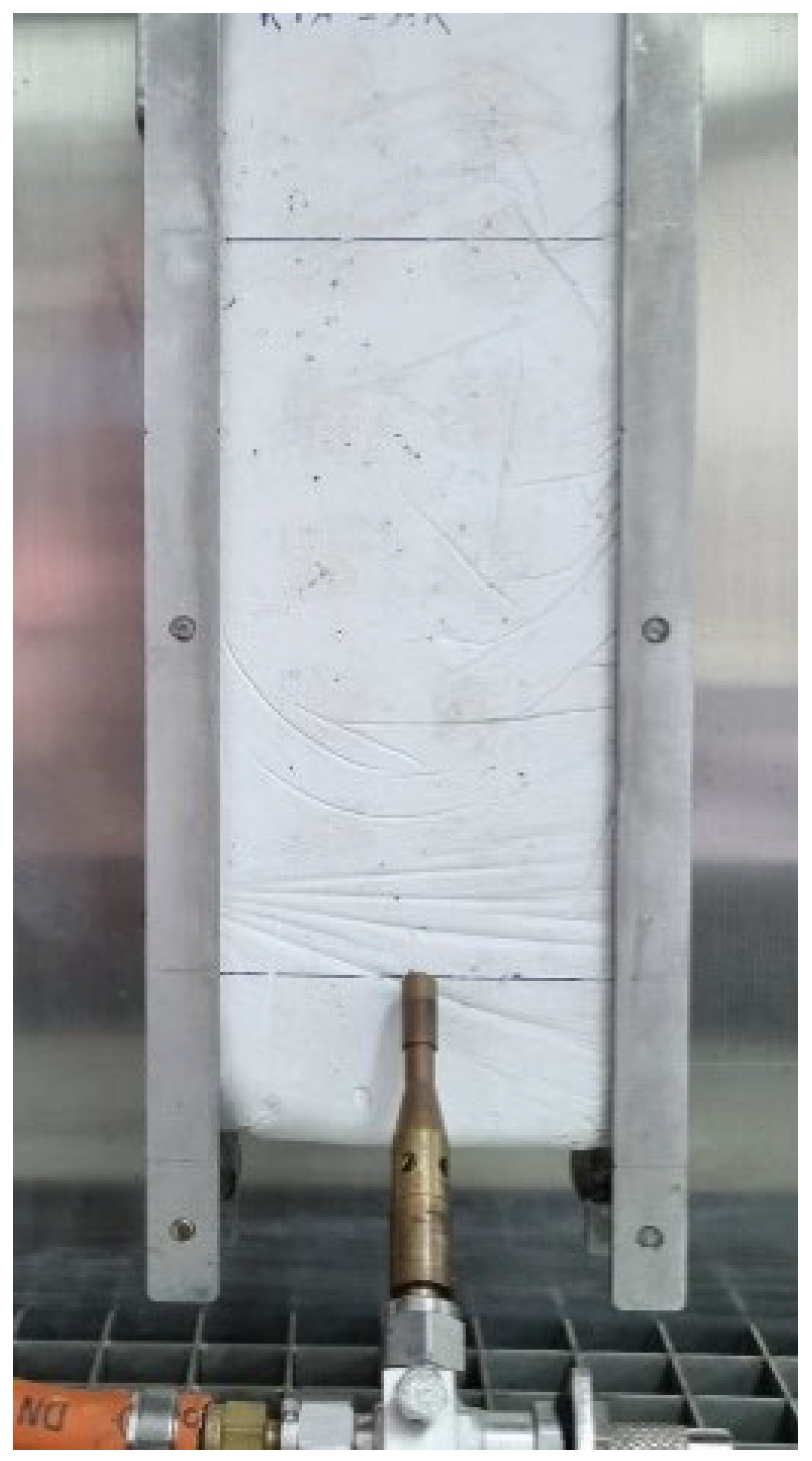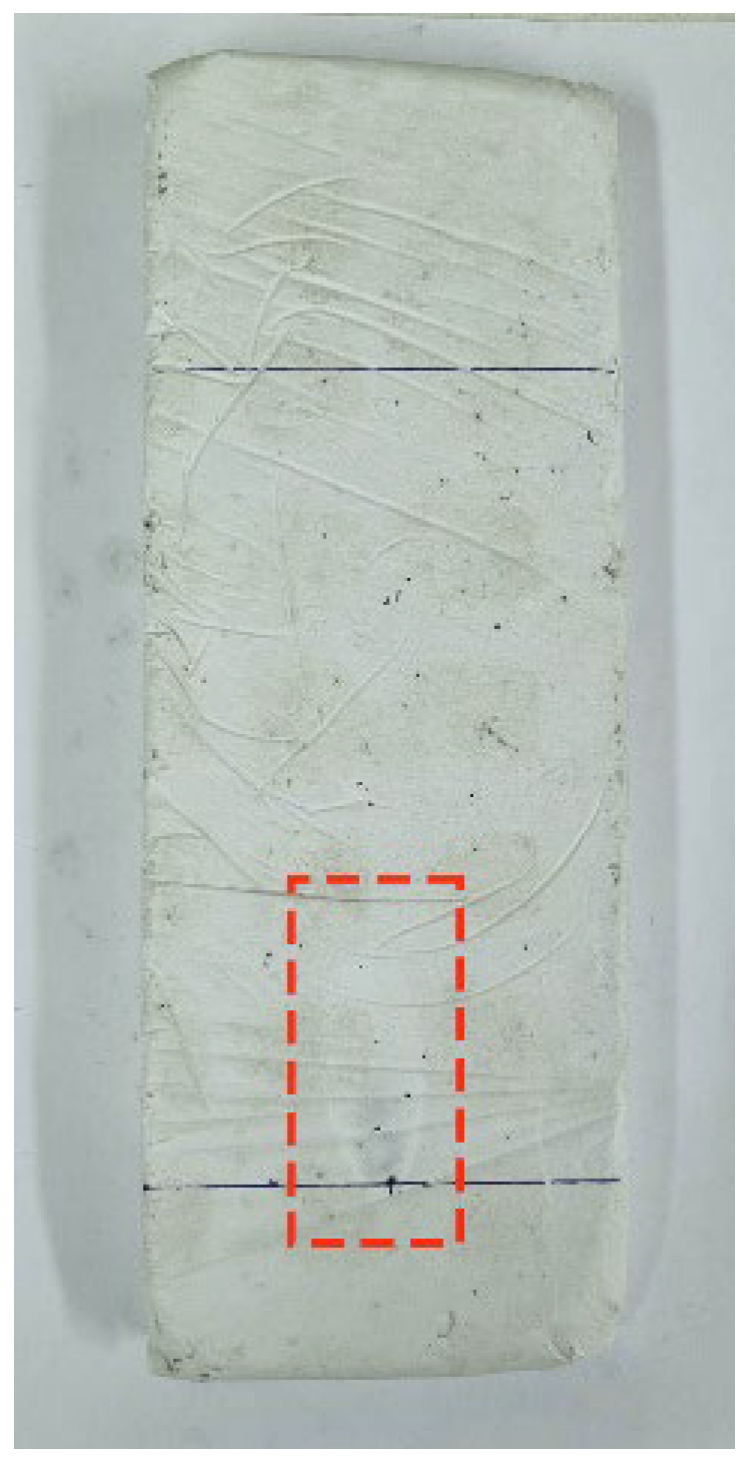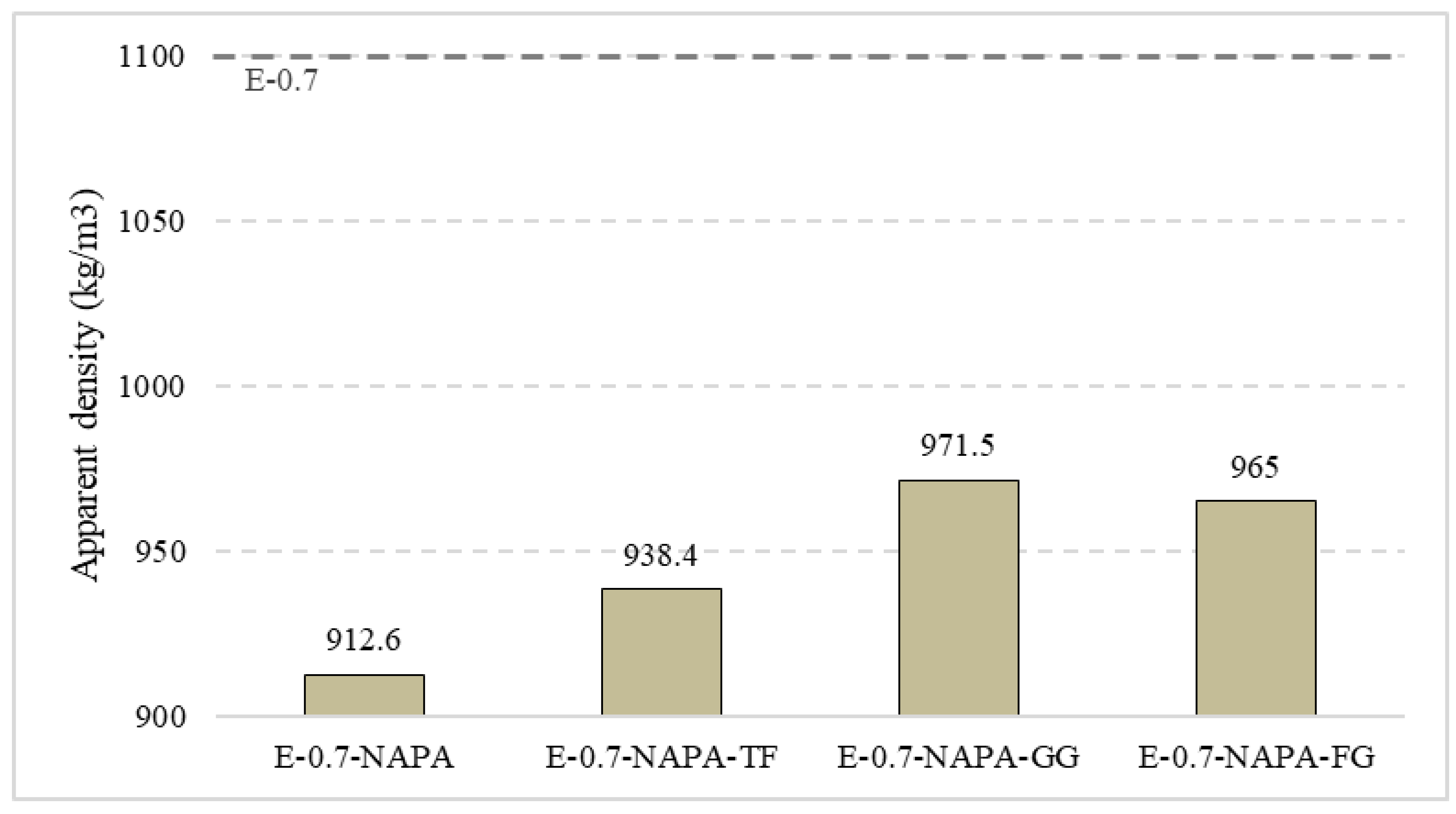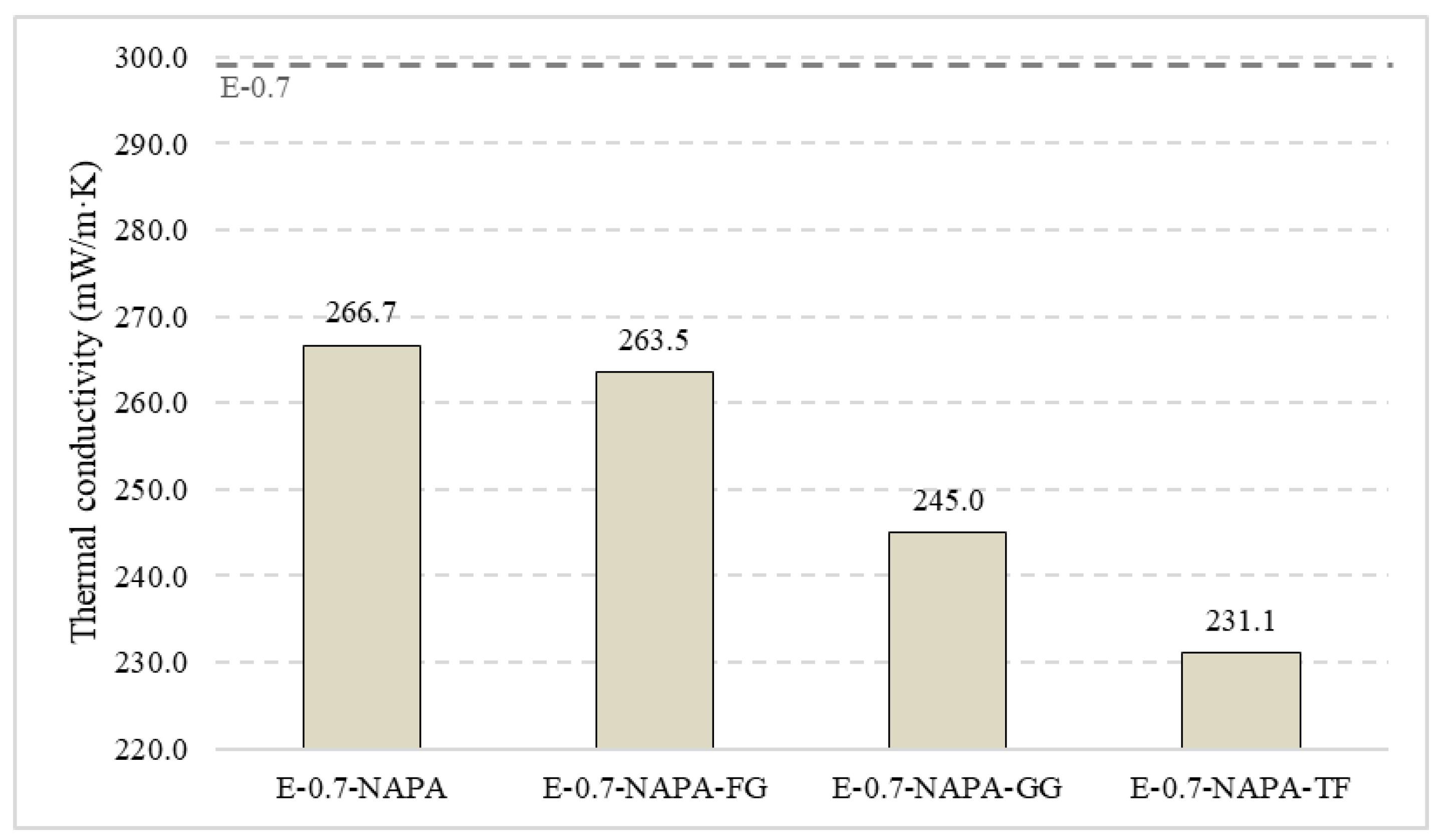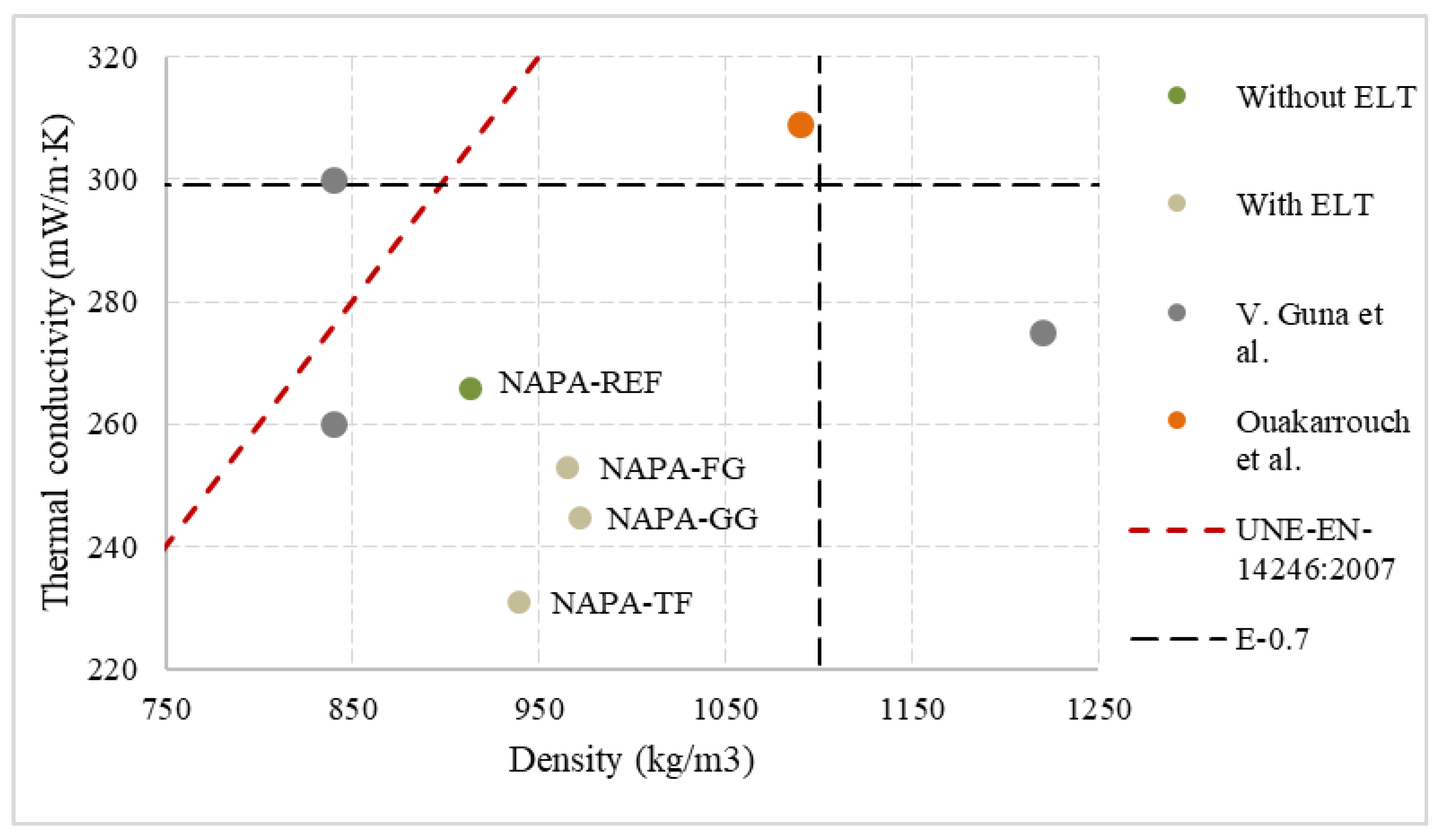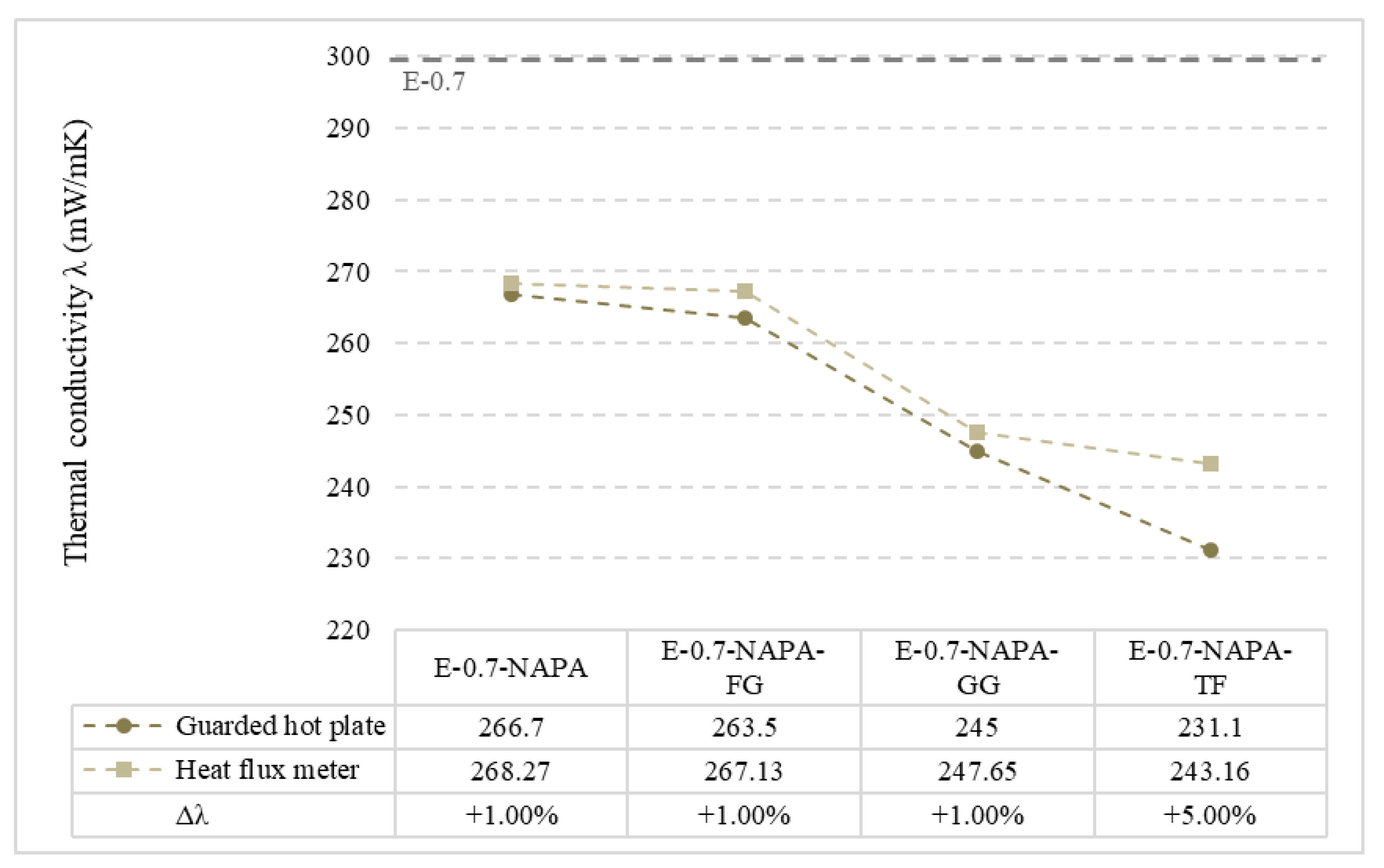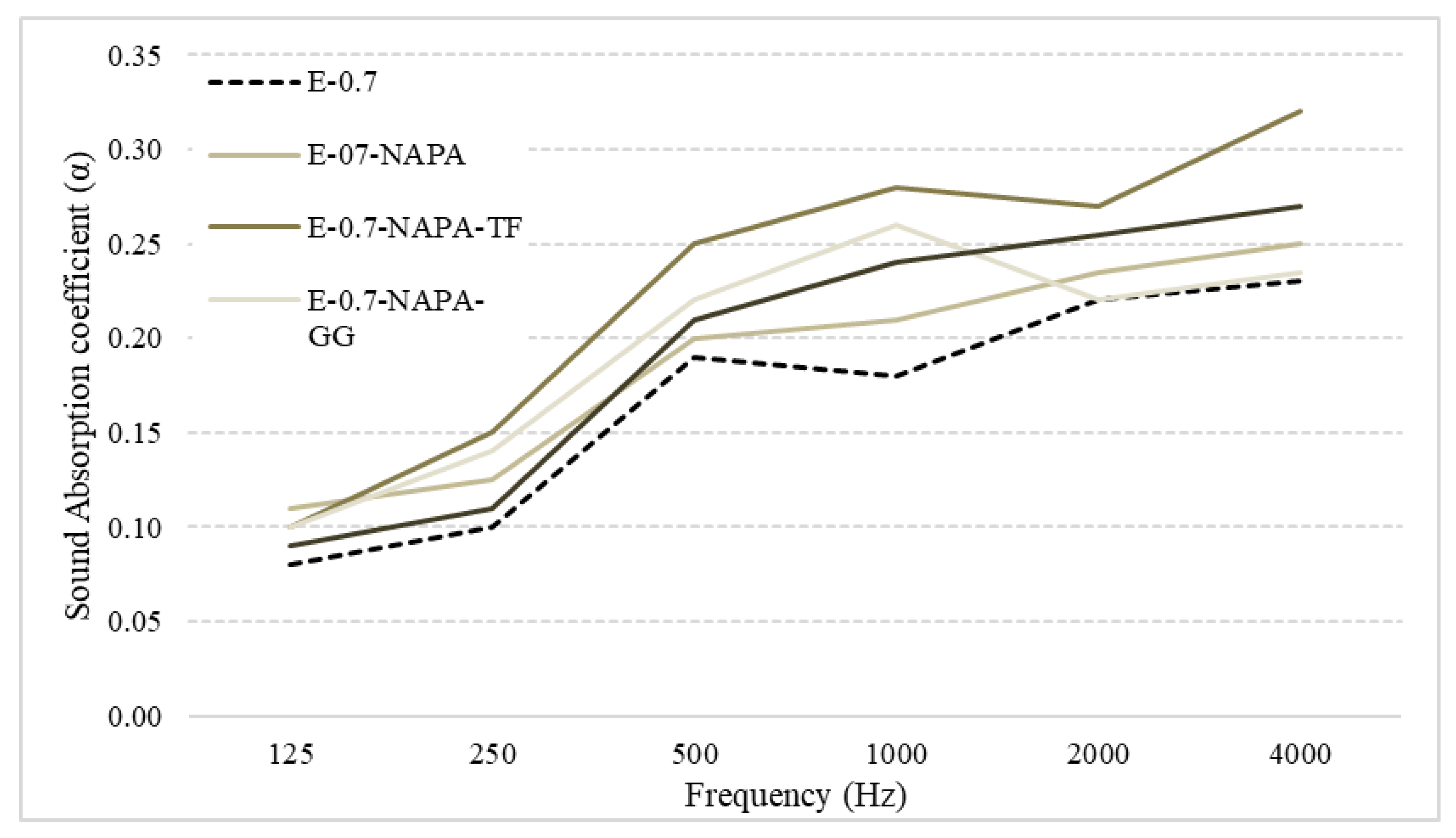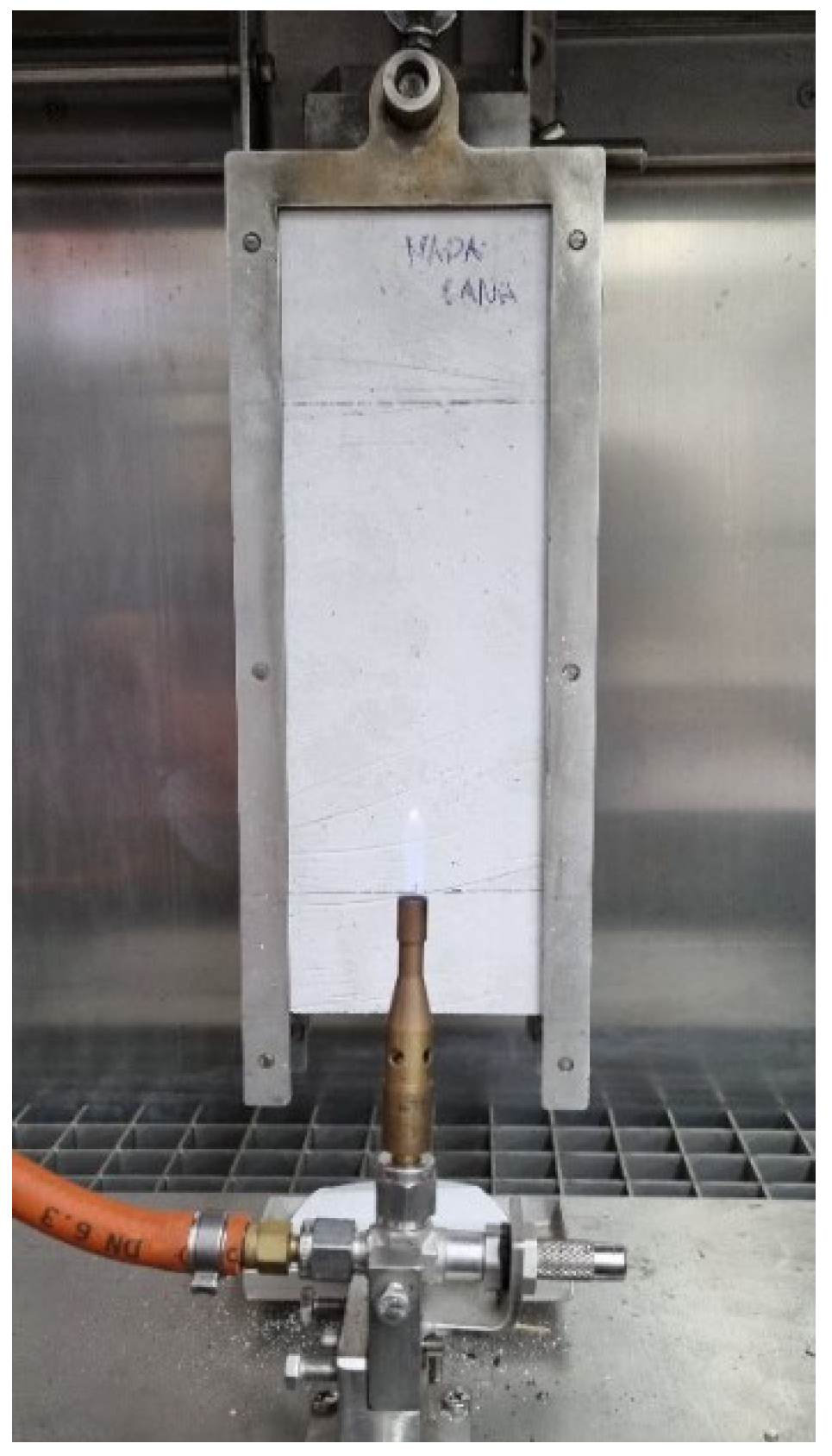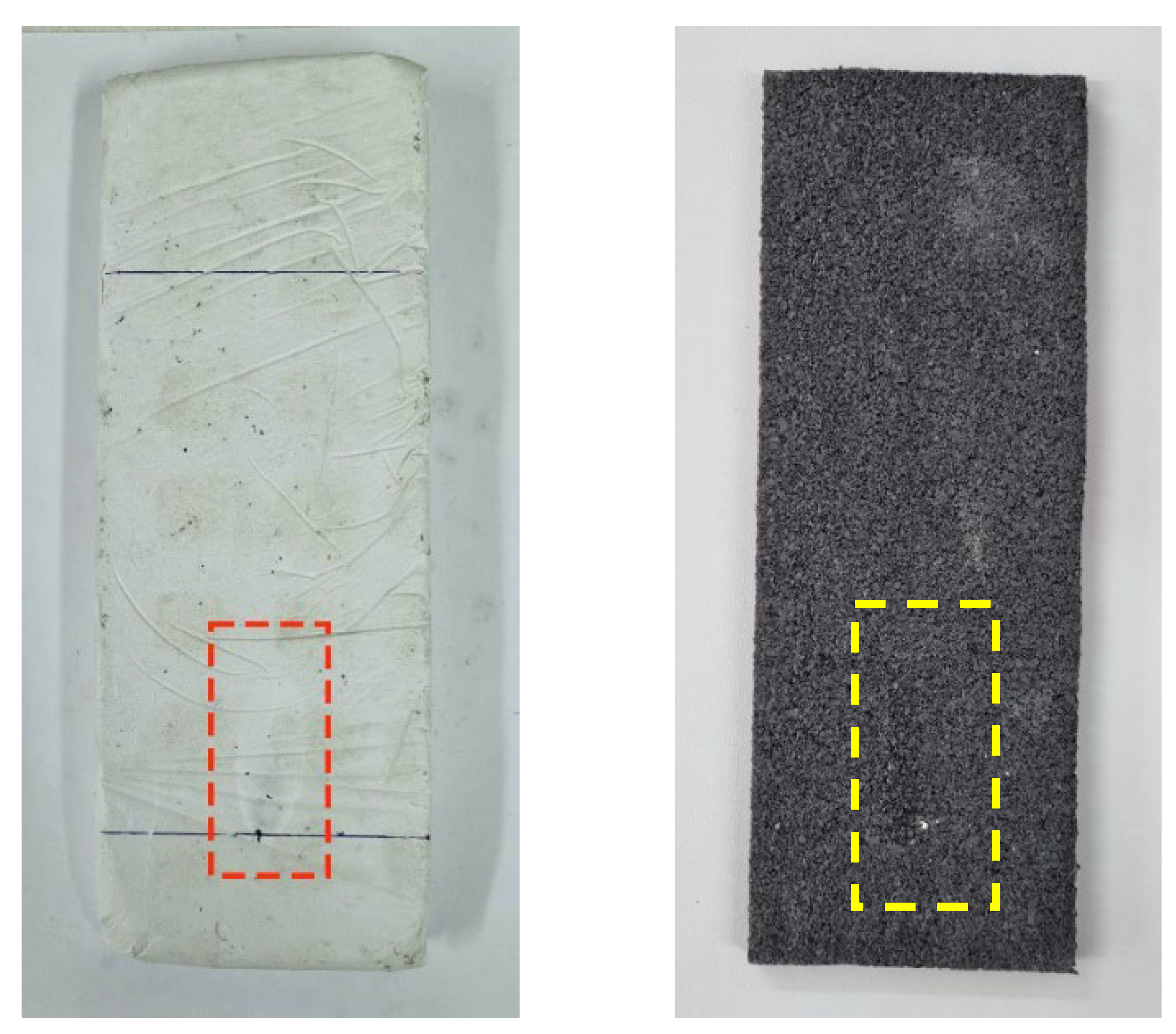1. Introduction
Of all the materials that are used in the building process, plaster is still today the one that is most demanded [
1,
2,
3]. The success of this material in construction lies in the fact that it is easy to obtain in nature. In addition, the treatment processes to obtain the final material needs less energy and economics resources consumption [
4]. In addition, plaster is a circular material since it can be fully reused during almost forever, as it can be transformed again in binder powder [
5,
6]. This is a characteristic that should be noted, as it contributes directly to the achievement of Sustainable Development Goals 11 and 12, [
7,
8]. These goals are related with a production and responsible consumption and sustainable cities and communities. Plaster is widely studied and applied to buildings due to several reasons. On the one hand, its versatility to create different shapes and its elegant aesthetic finish let it be applied to many places and make plaster the ideal material for the interior cladding of buildings, both walls and false ceilings. On the other hand, its good mechanical performance and its weight make it the most suitable material for these uses [
9].
However, in addition to the mechanical behaviour, its use in buildings requires other characteristics, such as reduced thermal conductivity and adequate acoustic behaviour. The aim of these requirements is to achieve comfort and reduce the energy consumption of buildings, as the building sector is one of the big energy resources consumers in the world [
10]. To improve these properties, there are two diverse types of studies in the literature. On the one hand, there are studies that make additions to modify the matrix. Most of the studies try to make the material more porous, provoking reactions in the matrix to create air pores in its interior. In all these studies, a significant reduction in thermal conductivity is achieved [
11,
12]. However, this leads to a considerable and undesirable reduction in mechanical strength [
10,
13]. On the other hand, it can be found studios that use wastes and fibres from diverse origin. In this way, there are several studies made with the addition of both, natural and synthetic fibres, trying to improve both mechanical and thermal resistance of the new materials developed. In these studies, the mechanical resistance increases in a significantly way, but thermal and other resistances achieve results similar to the reference values studied [
14,
15,
16,
17].
Acoustic performance significatively improves in those studies when the plaster becomes more porous. An acoustic absorption increases of 20% is achieved in these porous materials, especially in high frequencies [
18]. Moreover, other studies were carried out using lignin as additives, to check the acoustic absorption [
19]. The difference between the values achieved in the different samples tested were not so relevant (α = 0.15–0.30 in high frequencies). This sound absorption depends on the mixture humidity and the additives quantity [
20,
21].
Regarding waste additions, rubber from end-of-life tyres is one of the most abundant materials produced, with 355 million tyres produced each year [
22]. The main problem with this material is its storage. They end up occupying large areas of land, and, due to their flammable characteristics, this is huge problem that is difficult to manage [
23].
Despite this, it is a material that is widely used in construction. Most of the studies are focused on mortars and concrete. Due to this lower density, the main property that rubbers give to composites is a weight attenuation. This reduction is significatively higher than conventional aggregates like construction and demolition waste (CDW) or ceramic [
24]. The improvement of mechanical characteristics using end-of life tyres rubber has been demonstrated in several studies. Thomas et al. showed that the use of tyre rubber in mortars and concrete provides a better performance against acids attacks, which means that useful life of this material could increase in some environments [
25]. Roychand et al. concluded that particle size is a determining factor in both flexural and compressive strength. In this study, a previous solvent-water washing treatment of the rubber resulted in a compressive strength increase. However, the larger the size of the particle, the higher decrease in the bending strength of the plaster [
26].
Thus, the use of rubber as an additive is not very well studied in plaster composites. Regarding mechanical performance, Serna et al. showed a significant reduction in the compressive and flexural strength, up to 18%, with fractions from 1–5% volume [
27]. Herrero et al. also studied thermal performance, where small particle size additives of 30–40% by weight presented the best results [
28].
The aim of this study is to characterize a new plaster-based material with three different recycled materials obtained from end-of-life tyres; two of them are rubber shaped and one textile fibres, to make false ceiling plates with thermal conductivity and acoustic absorption improved. Thus, have a double impact in building sector. On the one hand, it contributes to a resource consumption reduction and energy saving. On the other hand, the use of end-of-life tyres materials as additives in building materials increases useful life span and contributes to the environment protection by reducing this waste.
3. Results and Discussion
This section shows the results obtained for the different characterisation tests performed in this research work. To compare all results obtained, E-0.7 has been taken as the reference.
3.1. Mechanical Characterisation
First, mechanical characterisation tests were performed, where density, flexural strength, and hardness were studied.
Figure 17 shows density values achieved in this experimental campaign. The polymer and ELT waste led to a decrease in the apparent density of all the samples up to 17%. This density loss is due to the big air holes resulting from the polymer. During the mixing, the polymer increases his volume up to 300 times, taking up more space and reducing gypsum content. Once dried, the polymer returns to its original size making this material more porous. Despite ELT density is smaller than gypsum, ELT wastes additive samples performed worse than E-0.7-NAPA. The best ELT sample was E-0.7-NAPA-TF, which decreased its density up to 17%, being closer to E-0.7-NAPA.
Types of additives are also related to flexural strength.
Table 5 shows how the use of additives led to a flexural strength decrease in all samples but 0.7-NAPA-TF, (0.34 kN) which performed better than E-0.7 (0.32 kN) reference sample. The main difference between both polymer and ELT rubber in their performance is that the polymer does not interact with gypsum during the test, as it returns to original size when samples are dried. ELT affects directly to their mechanical behaviour because there is no cohesion between gypsum and rubber and, despite of his higher tensile strength, their different elasticity leads to a worse performance of this mixture [
47]. ELT fibre tensile strength is also higher than gypsum, but there are better inner cohesion and achieve better and more homogeneous mixture. This, lead E-0.7-NAPA-TF to obtain the best results of all samples performed All composites got flexural strength values over UNE-EN 12,859 [
39] standard requirements (0.18 kN).
Surface hardness test and deformation results are analysed in
Table 6. E-0.7 (86 Shore C units) results were worse than E-0.7-NAPA-TF (88 Shore C units), and E-0.7-NAPA (89 Shore C units). This is due to the more water/plaster ratio, the less shore C hardness achieved [
48]. As the polymer can absorb vast amounts of water from the mixture, E-0.7-NAPA (89 Shore C units) achieved the best performance. When ELT textile fibre is added, this result decreases as this fibre also retains water. Samples with rubber, E-0.7-NAPA-GG and E-0.7-NAPA-FG achieved the worst results as rubber mixed with gypsum, weakening the final composite.
However, results are practically inversed in the surface hardness impact test. Samples without rubber achieved a worse result than those with rubber. This is due to rubber elasticity [
49], which allows it to absorb and reduce the load transmission trough the sample. With this, rubber size is also determinant, as can be seen. With a smaller size of rubber, load absorption capacity increases, as the load is more homogeneously distributed. In this test, E-0.7-NAPA-FG demonstrated the smallest footprint with 7.1 mm, compared to E-0.7, with 9 mm and achieved the worst result. Finally, deformation results demonstrate almost irrelevant deformation of the samples. As can be seen, all samples achieved smaller values than E-0.7 (12 μm), which was the highest deformation. E-0.7-NAPA-TF achieved the best result (9 μm) because fibre leads the composite to a more homogeneous distribution and collaborate as well as in flexural strength to a good behaviour. On the other hand, samples with rubber, E-0.7-NAPA-GG (42 μm) and E-0.7-NAPA-FG (40 μm) performed worse because of the lack of cohesion inside the sample and rubber elasticity.
3.2. Thermal Conductivity
In this section, both hot guarded plate and heat flux meter methods results are first presented and analysed. Then, they are compared.
Table 7 presents the samples conductivity and thermal resistance values obtained from the guarded hot plate tests performed. ELT rubber sample was also evaluated to get a reference value. This will allow analysis of the new composites behaviour.
A small mass variation can be observed in E-0.7 (0.02%), E-0.7-NAPA (0.02%), and E-0.7-NAPA-GG (0.04%). Although samples were covered with a thin plastic film, this variation is due to a water absorption from the cold plate, due to plates temperature. This small mass variation during the test caused by this water absorption was not significant and had no effect on the result.
Figure 18 shows the values achieved by the samples in guarded hot plate test performed. The additive of Sodium Polyacrylate decreased thermal conductivity up to 8%, from 290.1 to 266 mW/(m·K). Therefore, the addition of ELT rubber and textile fibre led to a decrease in all the samples thermal conductivity studied. The best value achieved was 231.1 mW/(m·K) in E-0.7-NAPA-TF, with a 20% reduction. Samples with ELT rubber performed worse than those with textile fibre. This is due to the higher mass presence and density into the matrix. The worst ELT additive sample value was obtained by E-0.7-NAPA-GG, which got a 9% decrease with respect to the reference. That means that the smaller rubber size, the higher conductivity value achieved.
To emphasise the results obtained,
Figure 19 shows a comparison of different values obtained by different authors in the literature as well as UNE-EN-14246: 2007 [
39] standard specifications. Studies compared have been selected for two reasons. First, the use of both natural and synthetic lightweight wastes. Then, to avoid mistakes in measurement comparison, studies compared used hot guarded plate method to determine thermal conductivity.
Values obtained by those samples with ELT additives are close to each other. As a main advantage, density is lower than reference in all samples, and all of them are behind standard limits. The study performed by Guna et al. used natural wool and coir fibre to develop thermal and moisture resistant ceiling tiles gypsum based [
11]. This study recorded 840 kg/m
3 samples densities, which is a low density. However, results are like the reference, and all of them are above those with ELT additive. The best value achieved is 260 mW/(m·K), and only E-0.7-NAPA performed worse. Ouakarrouch et al. developed a new light plaster by adding animal feathers. In this case, values obtained were worse than all compared values [
50].
On the other hand, heat flux meter tests results are presented in
Table 8. Aligned with Hot guarded plate test results, E-0.7-NAPA-TF was the sample which performed better with a 16% improvement in thermal conductivity value. As commented in guarded hot plate test results, the addition of ELT rubber and textile fibre decreased thermal conductivity values up to 16%. In these tests, values achieved were different than those achieved in lambda meter tests. To validate the two methods employed, a comparison of both heat flux meter and hot guarded plate methods results are presented in
Figure 20.
First, all samples but E-0.7-NAPA-TF demonstrated 1% difference thermal conductivities values with respect to guarded hot plate test results. This is due to a homogeneous distribution of different additives present in the samples. Rubber and sodium polyacrylate have a constant mass and volume. This led to a more homogeneous distribution in the mixture. The main difference is noticed in E-0.7-NAPA-TF with a 5% difference. This could be due to two main factors. On the one hand, despite textile fibre is distributed along the sample, due to its shape, it is not completely homogeneous. On the other hand, the Lambda-Meter machine measures the entire 150 × 150 mm2 surface, while heat flux meter measures a local region. This fact could directly affect the thermal conductivity measurements as it is not possible to ensure a textile fibre homogeneous distribution. Even so, difference values achieved ensures an enough accuracy to validate heat flux meter method and the test apparatus used as a valid test to characterise thermal conductivity.
3.3. Sound Absorption Coefficient
Figure 21 shows the measured sound absorption coefficient. These results show that the addition of both, Sodium polyacrylate and ELT wastes (rubber and textile fibre) improved in a significant way this material characteristics in all octaves studied. The most significant difference occurs at 1000 Hz and 4000 Hz. At 2000 Hz, results remain the same. From 125 to 500 Hz, the results agree with the literature, which marks a deficient performance in these frequencies [
51]. The highest sound absorption was reached by E-0.7-NAPA-TF at 4000 Hz (0.32). E-0.7 demonstrated the worst performance in all frequency octaves.
Finally, a mean value of each sample is obtained and shown in
Table 9. It should be noticed that all samples studied improved acoustic performance. E-07-NAPA improved 9.3% and main improvement was in 2000 Hz frequency. After that, the addition of ELT rubber led to an increase up to 19.5% (from 0.20 to 0.24), depending on the rubber size. Lastly, ELT textile fibre achieved a 35.6% improvement, which makes E-07-NAPA-TF the sample who performed better. The best improvements are achieved in 1000 Hz, where sound absorption coefficient difference is up to 0.1. This frequency range (500–2000 Hz) includes most of the main sounds, such as the human voice.
3.4. Fire Performance
According to fire standard UNE-EN-11925:1 [
46], contained in UNE-EN-14246 standard [
39],
Table 10 shows the fire ignitability test results performed. Neither gypsum nor sodium polyacrylate are flammable materials, unlike ELT wastes [
26,
47]. Initial weight was set to check any mass loss during the test.
This section may be divided by subheadings. It should provide a concise and precise description of the experimental results, their interpretation, as well as the experimental conclusions that can be drawn.
A negligible mass variation was registered in plaster samples due to superficial gypsum dust that fell after removed from the sample holder shown in
Figure 22. In all cases, this mass variation was around 0.1–0.2 g, a completely negligible value that does not affect to the test. ELT rubber sample mass did not change. Despite ELT’s flammability, none of the samples ignited. This is due to two main reasons.
This test applies a flame for thirty secs. To get ignited, a longer flame application time is required. In addition, in samples with ELT rubber and textile, this material is encapsulated within the gypsum, making combustion even more difficult. Regarding flame length, it was almost the same in all the samples, but in ELT rubber sample, which reached 55 mm. The mark set by the fire in the samples was small and almost invisible, as can be seen in
Figure 23. To totally classify these materials as Class B, UNE-EN-13823 [
52] complementary test would be necessary to perform as exposed in UNE-EN-13501-1 [
53].
3.5. Environmental Impacts: Global Warming Potential
Finally, a global warming potential analysis, was performed to determine these composites elaboration environmental impact. As far as end-of-life tyre is used in this study as the main additive, it is a great opportunity to reduce environmental impact produced by this great waste. To perform this analysis, it is necessary to determine what is functional unit (FU) in each material. For this environmental product declaration of E-35, gypsum [
54] and tyres [
55] were used. These documents show the environmental cost of these products. In this studio, ranges considered were from A1 to A3 for E-35, and C1–C4 for tyres. Sodium polyacrylate (NAPA) information referred to this topic is not available after consulting with supplier business. The aim of this comparison is to set a potential reduction of main resources and how it potentially reduces environmental impact.
Table 11 shows analysis conducted, and values of potential global warming potential reduction achieved. It can be noticed that only with sodium polyacrylate additive, a 22% decrease of CO
2 emissions is achieved. This is due to a smaller E-35 quantity used. End-of-life tyre additive also got a reduction of this global warming potential. Highest CO
2 decrease was achieved in E-0.7-NAPA-FG and E-0.7-NAPA-GG, with a 34% CO
2 potential reduction. Both achieved the same reduction as they have the same quantity of material in the mixture. The use of textile fibres reached only a 20% CO
2 potential reduction, but it is only due to the smaller quantity of this material with respect to E-0.7-NAPA-FG and E-0.7-NAPA-GG. With these results it is possible to confirm that the use of ELT recycled materials reduces in a significant way the final product environmental impact (GWP).
4. Conclusions
End-of-life tyre waste is one of the most contaminating materials existing nowadays. In view of this, its use as additive in building materials represents a potential a solution to this problem and a new life improving some of the required characteristics in this sector. In this study, recycled granulated rubber, and recycled textile fibres from end-of-life tyres are presented as additive to develop false ceiling gypsum plates. Thus, this study achieved important results related to this additive, as highlighted next:
The addition of both ELT recycled rubber and textile fibre decreased material density up to 15%. This leads to a better material elaboration workability, easier transport, and assembly;
The addition of sodium polyacrylate improves thermal conductivity up to 8% with respect to the reference. Therefore, the addition of ELT rubber and textile fibre decreases thermal conductivity. Thus, textile fibre was the additive which performed better in this characteristic;
Thermal conductivity values obtained from both guarded hot plate and heat flux meter methods were strongly related, with differences around 1%, having only one exception (5% for the ELT textile fibres), which is also a remarkable result;
Acoustic absorption values showed a significant improvement in all samples studied with respect to the reference. However, it could perform even better if samples were perforated. This would change samples aesthetic and that is the main reason it was not done in this study;
Ignitability test resulted in no ignition, nor a significant mass reduction. Due to this, and according to UNE-EN-13501-1 [
53], samples can be classified as “Class E”;
Finally, regarding environmental behaviour, only by reducing the amount of matrix material (gypsum/plaster) can a reduction of energy and resources consumption be achieved. In this study, the use of ELT recycled rubber and textile fibres can reduce up to a 34% of CO2 emissions with respect to the reference.
Plaster-based composites are highly studied, but there are few studies in the literature with the addition of ELT wastes, rubber, and textile fibre. In this study, results shows that the elaboration of new plaster-based material with these wastes still have a lot of chances and ways to be studied.


